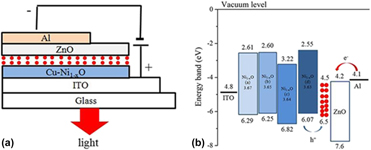Crossref Citations
This article has been cited by the following publications. This list is generated based on data provided by
Crossref.
Kim, Sun-Kyo
Yang, Heesun
and
Kim, Yong-Seog
2020.
Effects of double heat treatment of NiO hole transport layer on the performance of QLEDs.
Journal of Materials Science,
Vol. 55,
Issue. 36,
p.
17046.
Brewster, David A.
Bian, Yifeng
and
Knowles, Kathryn E.
2020.
Direct Solvothermal Synthesis of Phase-Pure Colloidal NiO Nanocrystals.
Chemistry of Materials,
Vol. 32,
Issue. 5,
p.
2004.
Zhang, Yidong
Zhao, Lei
Jia, Huimin
and
Li, Pinjiang
2020.
Study of the electroluminescence performance of NiO-based quantum dot light-emitting diodes: The effect of annealing atmosphere.
Applied Surface Science,
Vol. 526,
Issue. ,
p.
146732.
Zhang, Yidong
Wang, Xinmin
Chen, Yifeng
and
Gao, Yuanhao
2020.
Improved electroluminescence performance of quantum dot light-emitting diodes: A promising hole injection layer of Fe-doped NiO nanocrystals.
Optical Materials,
Vol. 107,
Issue. ,
p.
110158.
Gong, Yongshuai
Zhang, Shuai
Gao, Huaizhi
Ma, Zongwen
Hu, Siqian
and
Tan, Zhan'ao
2020.
Recent advances and comprehensive insights on nickel oxide in emerging optoelectronic devices.
Sustainable Energy & Fuels,
Vol. 4,
Issue. 9,
p.
4415.
Huang, Lixiang
Wang, Yukun
Zhu, Xinglin
Zhao, Xinyu
Li, Guoxin
Li, Lei
and
Sun, Wenhong
2021.
Mg-Doped Nickel Oxide as Efficient Hole-Transport Layer for Perovskite Photodetectors.
The Journal of Physical Chemistry C,
Vol. 125,
Issue. 29,
p.
16066.
Zhang, Yidong
Dong, Zhenwei
and
Li, Pinjiang
2021.
Construction of electron and grain boundary barrier in quantum dots light-emitting diodes: The role of NiO interface coating.
Optical Materials,
Vol. 117,
Issue. ,
p.
111204.
Choi, Seung-Gyun
Seok, Hae-Jun
Rhee, Seunghyun
Hahm, Donghyo
Bae, Wan Ki
and
Kim, Han-Ki
2021.
Magnetron-sputtered amorphous V2O5 hole injection layer for high performance quantum dot light-emitting diode.
Journal of Alloys and Compounds,
Vol. 878,
Issue. ,
p.
160303.
Shin, Jae Seung
Kim, Mingye
Ma, Jin Hyun
Jeong, Jun Hyung
Hwang, Hui Wung
Kim, Jeong Won
and
Kang, Seong Jun
2022.
Solution-processable Li-doped transition metal oxide hole-injection layer for highly efficient quantum-dot light-emitting diodes.
Journal of Materials Chemistry C,
Vol. 10,
Issue. 14,
p.
5590.
Madani, Sepideh
Tesfamichael, Tuquabo
Wang, Hongxia
and
Motta, Nunzio
2022.
Study of Pb-based and Pb-free perovskite solar cells using Cu-doped Ni1-xO thin films as hole transport material.
Ceramics International,
Vol. 48,
Issue. 11,
p.
15207.
Bounegab, Abdelhamid
and
Boulesbaa, Mohammed
2023.
Ellipsometric studies of nickel oxide thin films synthesized via spray pyrolysis at varied substrate temperatures for optoelectronic applications.
Spectroscopy Letters,
Vol. 56,
Issue. 7,
p.
398.
Rani, Sweta
and
Kumar, Jitendra
2023.
Modeling charge transport mechanism in inorganic quantum dot light-emitting devices through transport layer modification strategies.
Journal of Applied Physics,
Vol. 133,
Issue. 10,
Bhujel, Kamal
Thangavel, R.
Pal, Kiran Kumari
Sardar, Pritam
Nayak, Dipali
Singh, Ningthoujam Surajkumar
and
Rai, Suman
2024.
Cu-doped NiO thin film's structural, optical, and electrical properties and its negative absorption behaviour in the Infra-Red region.
Physica B: Condensed Matter,
Vol. 688,
Issue. ,
p.
416129.
Cai, Fensha
Li, Meng
Zhou, Yamei
Tu, Yufei
Liang, Chao
Su, Zhenhuang
Gao, Xingyu
Zeng, Zaiping
Hou, Bo
Li, Zhe
Aldamasy, Mahmoud H.
Jiang, Xiaohong
Wang, Shujie
and
Du, Zuliang
2024.
Dipole-tunable interfacial engineering strategy for high-performance all-inorganic red quantum-dot light-emitting diodes.
Nano Energy,
Vol. 119,
Issue. ,
p.
109050.





